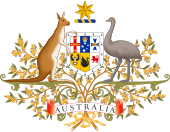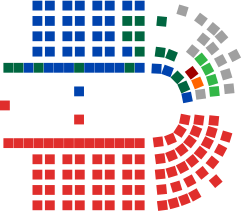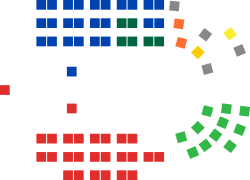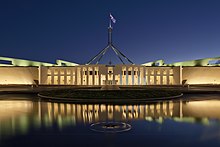Parliament of Australia
The Parliament of Australia is the federal governing system in Australia. It was formed on May 9, 1901. The parliament is bicameral, which means it has two houses, the House of Representatives and the Senate. It was copied mainly from the way the United Kingdom's Parliament was run, the Westminster system, but it also has some ideas from the United States Congress. The laws which control the way the parliament is set up and its powers are part of the Australian Constitution. The Parliament meets in a special building, Parliament House, in Canberra.
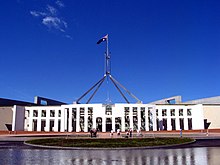
The parliament has four main functions:[1]
- It makes, changes and improves the laws (legislation)
- Represents the people of Australia
- It watches what the government is doing
- It is where the government is formed
The Australian Parliament first met in the Royal Exhibition Building in Melbourne in 1901. It then took over the Victorian Parliament in Melbourne until it moved to Canberra in 1927. A new building for the Parliament was finished in 1988 to celebrate 200 years of European settlement in Australia.
House of Representatives
changeThere are 151 members of the House of Representatives, each one elected for a three-year term.[2] Each member represents about 150,000 people living in an electorate. The boundaries of each electorate are often changed to keep the number of people in each electorate is the same.[3] The size of each electorate can be very different. The electorate of Durack, in Western Australia, covers an area of 1.3 million square kilometres, while Wentworth in New South Wales is only 26 square kilometres.[3]
The government is formed by the political party (or group of political parties) who have the most members in the House. The House is set out in the British style, even using the green colours of the House of Commons.[4] The Speaker sits at the front; the members of the government sit on the seats to his right, and the opposition sits on the seats to his left. The Prime Minister, the Leader of the Opposition, government ministers, and the shadow ministers, sit at a large table in the centre.
Senate
changeThe Senate is the upper house of the Australian Parliament. There are 76 members in the Senate. There are 12 senators for each Australian state, and 2 for each territory.[5] The Senate makes and changes legislation. To become law, legislation must be passed by both houses and then be signed by the Governor-General.[5]
The colours in the Australian Senate are red, as in the British House of Lords. The senators sit in a U shape around a central table. The head of the Senate, known as the President, sits at the head of the table. On their right are the government senators, and on their left the opposition. Senators from minor political parties and Independent senators sit at the bottom of the U shape.[5]
Related page
changeNotes
change- ↑ Including 14 Liberal National Party of Queensland (LNP) MPs who sit in the Liberals party room
- ↑ Including 6 Liberal National Party of Queensland (LNP) MPs who sit in the Nationals party room
- ↑
- ↑ Stuart Robert (LNP) resigned from his seat of Fadden on 18 May 2023. A by-election will be held in his seat later this year.
- ↑ Including three Liberal National Party of Queensland (LNP) senators who sit in the Liberals party room.
- ↑ Including two Liberal National Party of Queensland (LNP) senators and one Country Liberal Party senator who sit in the Nationals party room.
- ↑ David Pocock, Lidia Thorpe and David Van
References
change- ↑ "Functions of Parliament". Fact Sheet 29. Parliamentary Education Office. Archived from the original on 2013-01-03. Retrieved 2010-06-10.
- ↑ "Senators and Members". Australian Parliament House. Archived from the original on 12 January 2022. Retrieved 12 January 2022.
- ↑ 3.0 3.1 "Electric Electorate". Civics and Citizenship Education. Education Services Australia. Archived from the original on 2011-03-06. Retrieved 2010-06-10.
- ↑ "House of Representatives". Parliamentary Education Office. Archived from the original on 12 January 2022. Retrieved 12 January 2022.
- ↑ 5.0 5.1 5.2 "Fact sheet - Senate". Parliamentary Education Office. October 24, 2012. Archived from the original on January 3, 2013. Retrieved January 4, 2013.
Other websites
change
